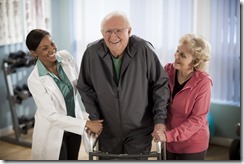 My dad recently went through a difficult transition: from the ER to the hospital to rehab and then home, all as a result of passing out due to orthostatic hypotension (falling blood pressure when standing or stretching).
My dad recently went through a difficult transition: from the ER to the hospital to rehab and then home, all as a result of passing out due to orthostatic hypotension (falling blood pressure when standing or stretching).
These movements from place to place and practitioner to practitioner are called “care transitions” and occur as a patient’s needs change.
Unfortunately, handing a patient off from one team to another is not something that’s been perfected in our healthcare system.
Since a majority of care transitions occur among seniors who may experience significant physical or cognitive challenges, having a spouse, family member or friend who can advocate for them is crucial to their recovery. For my dad’s sake, thank goodness we were there.
After three nights in the hospital, my dad was transferred to a rehabilitation center, a place where he could receive physical and occupational therapy and nursing care to regain his strength before he returned home.
My mom and my sister Paula accompanied him on his transition to this new location.
Shortly after their arrival, one of the staffers asked my mom to fill out a medical order for life sustaining treatment, or MOLST, on my dad’s behalf.
This two-sided form had some pretty intense questions: Did my dad want to be resuscitated, be placed on a ventilator, use a C-PAP, have a feeding tube or artificial hydration?
My mom and dad have an advance directive list—a set of written directions to follow if they’re unable to speak for themselves— but it isn’t an easy document to interpret in an emergency situation. Having a MOLST in place allowed the physicians and staff to know what to do quickly in regard to the care of a patient.
After some family conversation the MOLST was completed, the doctor signed it, and my mom received a copy. Having my mom and sister there to discuss the many options with my dad was hugely beneficial.
On day four in the rehab facility, we were invited to a family meeting with my dad’s nursing home care team to evaluate his progress. They approved his discharge with the caveat that he was to continue receiving care (physical therapy, occupational therapy and speech therapy) at home until such time when he was no longer making progress.
With my dad back at home and after 48 hours of not hearing from anyone, we called the in-home medical company. We were told they were backlogged and it would be at least another four days before they could book PT or OT for my dad.
I said that would make it almost a week before my dad had any care since he was released from rehab, and that couldn’t be what was intended when he was discharged.
A nurse arrived the next morning— again underscoring how having an advocate can help.
Coordinating schedules and following directions for each practitioner has been a challenge. With three to five practitioner visits per week, a new person arrived almost every time my dad had therapy and his progress assessed.
Even with a good computer system to capture patient data, we wondered how all these new people who were seeing my dad for the first time could determine his progress.
Today my dad is home, still receiving care and slowly getting back to his pre-hospitalization form. My sisters, mom and I were described on my dad’s rehab chart as a very involved family. Good for us: We truly think that has contributed to my dad’s recovery.
If you’d like to learn more about navigating care transitions, Senior Concerns will be presenting “How to Take Charge of Your (or Your Loved One’s) Hospital Stay” from 5:30 to 7 p.m. Tues., April 29 at our office, 401 Hodencamp Road, Thousand Oaks.
This panel discussion will include Jeff Pearl, M.D., physician emeritus Kaiser Permanente; Teri Helton, RN, from Livingston Memorial Visiting Nurse Association; and Charna Posin, a patient advocate.
Advance reservations and a $10 donation per family for handouts are requested. You can register by calling (805) 497-0189.
More ...
Tags: care transitions,MOLST